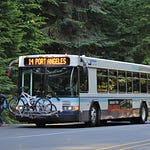After cancelling a scheduled interview, Olympic Medical Center Commissioner Ann Henninger submitted written answers to CC Watchdog — addressing her dual role with the Jamestown Tribe, OMC’s $70 million in recent losses, and the hospital’s ongoing struggle to rebuild trust with patients and taxpayers. Henninger insists the hospital is on the mend, partnerships are vital, and transparency is improving — but tomorrow voters will decide whether her reassurances are enough to restore public confidence in OMC’s leadership.
Conflicts of Interest and Ethical Concerns
1. Many people may not realize that you work for the Jamestown Tribe — a corporation that competes directly with OMC in several areas. That’s raised concerns about whether there’s a conflict of interest in serving on both sides of that relationship. How do you separate those roles and reassure voters that your loyalty is to OMC’s patients and taxpayers?
I am a Registered Nurse for the Jamestown Tribe. I am also a Nurse Manager at the Sequim Dungeness Health & Wellness Clinic, a Child Care Health Consultant, a Certified Rural Health Nurse, and a Sexual Assault Nurse Examiner (SANE) Fellow. Annually, I sign a conflict of interest document at OMC on which I disclose all apparent or perceived conflicts of interest. If any decisions come before the Board that fall into either category, I recuse myself from the vote. To date, there have been no conflicts re: Jamestown Tribe.
OMC and Jamestown partner together to provide healthcare in Clallam County. We rely on one another to meet the needs of our community.
2. Your husband also works at OMC. Do you see any potential conflicts when the board makes decisions that could affect staff or compensation?
My husband has been a physical therapist for Olympic Medical Home Health for 25+ years. Any vote related to union contracts or compensation for Home Health that comes before the Board mandates that I recuse myself, and I have done so every time.
3. There’s also public discussion about the tribe’s growing role in healthcare and whether OMC may shift unprofitable but essential services, like primary care or psychiatry, to Jamestown, where reimbursement rates are higher. Would you see that as a good partnership or a loss for OMC?
I am unsure where this discussion is taking place, but right now the topic is completely hypothetical. If such decisions were deemed prudent and in OMC and our community’s best interests, I would not be opposed to continuing our established partnership with JamestownHEALTH in ways that look different from how they are right now, so long as the community’s health needs are met, since that is the most important thing.
Healthcare in the USA is increasingly regional, and OMC already partners with multiple entities to ensure care needs are addressed.
Financial Oversight and Accountability
1. Between 2022 and 2025, OMC lost more than $70 million. As board president, how closely were you monitoring those losses, and what actions did you take to reverse them?
To my mind, a key consideration behind your question is why OMC has had these losses.
• We have a poor payer mix wherein 85% of our patients are covered by government insurance, which pays abysmally less than the cost of care provided. That is best addressed by ongoing, mutual, bipartisan advocacy efforts to ensure that every rural hospital in America gets paid at cost.
• Expenses for staffing and supplies are increasing at a faster rate than revenues, a challenge faced by many health systems across the USA.
• Operating costs due to an increase in the cost of supplies and services are consuming an even larger portion of OMC’s operating revenue than before the Pandemic, leaving OMC with fewer resources to cover other expenses.
• The Pandemic impact exacerbated OMC’s existing financial and operational struggles, especially regarding staffing shortages, spikes in the cost of materials and labor, and the hiring of contract or traveler employees.
• Payments to temporary (locums tenens) staff have added to the financial burden.
I have been tracking financials diligently as Board President and fighting for OMC’s financial integrity. (I am sure you and your readers know that the Board is charged with governance, and the C-suite is responsible for the daily management of operations.)
Actions taken include: at the resignation of the prior CEO, immediately hiring an interim CEO who is highly skilled in turnaround endeavors (who in turn hired an interim CFO who’s a financial expert and teacher); asking for monthly financial reports; requesting more information to be shared in said reports; supporting the actions of the ALT: creation of dashboards to demonstrate and measure metrics and successes; increased discipline in budgeting; renegotiating supplier contracts; freezing hiring and capital expenditures, boosting operational efficiencies; expecting providers to increase productivity to meet patients’ needs, capacity, and productivity goals; decreasing the use of contract labor; optimizing billing and record-keeping; and monitoring and adjusting staffing needs based on patient census.
These are among several ways to stabilize and improve OMC’s finances, and the management team is actively working on those with full Board support. OMC is actively in turnaround, our situation is recoverable, and change is taking place for the betterment of OMC, and consequently, our patients, staff, employees, and providers. Leadership is challenging any entrenched mindsets while seeking and receiving insights, ideas, and suggestions from employees and providers to improve the key metrics of the hospital, operationally and financially.
Our affiliation with UW Medicine also brings promise.
2. The interim CFO recently said that even as revenues declined, OMC continued spending heavily on new equipment and contracts. Since those expenditures require board approval, why wasn’t spending curbed sooner? Can you recall any major purchases the board rejected during that time?
Interim CFO Mr. Stillman stated that, as the hospital’s revenues were dropping, spending on new equipment and other expenses stayed the same.
With every proposed expenditure, capital or otherwise, the CEO can move forward if the financial threshold is under $249,000 and the CEO consults with the CFO and the rest of the ALT – Administrative Team. Above that threshold, Board approval is required.
All significant purchases must first go through the Budget, Finance, and Compliance Committee, which then recommends purchasing—or not—to the full Board.
At multiple points along the way, this stewardship question is always asked, “Is this in the budget?” In other words, “Is this planned for? Is now the right time? Can we afford to do this? How will this benefit OMC? What is the return on this investment?”
The Board relies on experts in management (ALT) for financial and operational information as well.
There were purchasing declinations or deferrals in Information Technology (IT) and Diagnostic Imaging (DI). The ALT also declined purchases through prudent stewardship decisions; these thus did not come before the Board.
3. Critics have pointed out that former CEO Darryl Wolfe received satisfactory evaluations and raises despite these mounting losses. How do you explain that, and how is accountability handled now?
Just as an FYI, hospital CEOs in the United States earn, on average, between $250K–$450K+ per year, with those at larger health systems earning up to $1M/year.
In addition to a base salary, an OMC CEO may receive incentives based on hospital profitability and quality measures, access to retirement plans and benefits, health insurance, and car and phone allowances.
As I am sure you and your readers understand, Mr. Wolfe’s performance reviews are confidential personnel matters.
I can share that the CEO – the sole ‘employee’ of the Board - sets personal goals and metrics to meet annually, with recommendations or focus area suggestions provided by the Board, which may make additional adjustments before approving these goals. The degree of accomplishment of said goals will determine any compensation increases or incentives received.
The Board performs an annual CEO evaluation, with scrutiny given to the goals set and achieved. A compensation increase is not a given.
Mr. Wolfe’s historical compensation and increases are publicly available. He received salary increases when he became the CEO of OMC in August 2020 ($212K), in May 2022 ($275K), and in December 2023 ($283K).
RE: how is accountability managed now…the Interim CEO, Mr. Gregson, receives performance feedback regularly from Witt Kieffer after the Board Governance Committee meets with them monthly. Mr. Gregson also accepts feedback during his weekly 1:1 meeting with the Board President, as well as from any Board member at any time. His performance will be more formally evaluated in December 2025.
4. Do you believe the board has the right mix of experience? Some feel it’s too heavy on political backgrounds and too light on medical and financial expertise. Would you support expanding the board’s qualifications or structure?
In the current and at least one prior commissioner race, partisanship has been marked, which is both unethical and unfortunate since service as a Public Hospital District Commissioner is and must remain a nonpartisan role. Partisanship has no role in Board decision-making – ever.
Public hospital boards don’t take sides in politics. Instead, their focus must be where it should be -- on the health and well-being of everyone in the community.
Here’s why that matters: A nonpartisan board makes sure the hospital is run for the benefit of everyone, not for any political group or private interest. The goal is simple: better care for the whole community. When a hospital stays out of politics, people can feel confident that decisions are made for the right reasons—patient care, safety, and community health. That trust helps everyone feel welcome and supported. Without political pressure, the hospital can focus its time and money where it really counts—like keeping emergency services open to all, upgrading equipment, and improving patient care. Most public hospitals are nonprofits, which means they’re not allowed to get involved in political campaigns. A nonpartisan board helps keep everything in line with the law and protects the hospital’s nonprofit status. Politics can change fast—but health care needs stability. A nonpartisan board helps the hospital plan for the long term and make decisions that stay true to its mission. Because it’s not political, the board attracts all kinds of talented people who want to give back and make a difference. Being nonpartisan helps public hospitals stay focused on what really matters — caring for the community and keeping people healthy.
Diversity of experience on ANY Board is critical for success. The current Board constellation includes a healthcare clinician, a finance expert, an elder advocate, with the four remaining commissioners retired from careers in nursing, healthcare architecture, border patrol, and as director for hospital environment and safety, respectively.
Since every Public Hospital District (PHD) Board member is elected and not self- selected, the practice of Board succession planning is not possible.
If and when a vacancy occurs and a commissioner appointment is necessary, however, there is an opportunity for the entire Board to select a candidate tocomplete the term.
To that end, we have a “Board member skills and experience matrix,” which I developed, that helps us identify strengths, expertise, and skills among current Board members. This information, in turn, aids us in identifying the best candidate to be appointed. (The public witnessed this process earlier this year when Commissioner Sanders was appointed to fill the vacancy left by Phyllis Bernard).
I would not support expanding the Board structure in terms of the number of commissioners on the Board. Out of 57 PHDs in Washington, only 3 have boards with seven commissioners. Most have 5, while many have 3.
Leadership, Staffing, and Culture
1. Following the resignations of the CEO, COO, and CFO, morale among hospital staff has reportedly dropped. How would you describe the current climate within OMC?
The CEO resigned for personal reasons. The COO returned to Oregon to accept planned employment. The CFO retired to care for an ailing family member.
Morale has not decreased because of these departures.
On the contrary, what I see and hear regularly is great enthusiasm for the initiatives being implemented and gratitude for our new leadership. People are generally thrilled with the changes being implemented (“We have been wanting and waiting for this! Thank you!” and “Thank you for hiring Mr. Gregson – he has great ideas!”) and are themselves bringing forth solutions and ideas to the Interim CEO and other leadership regularly. Employees feel increasingly seen and heard and are participatory in processes. They are taking ownership.
At the same time, I acknowledge that change is not easy and there may be resistance to doing things differently than has been done in the past.
The greatest strength of OMC is our people – employees, staff, providers – and we need, value, and appreciate them.
2. Would you support board members meeting privately with frontline employees — not through surveys, but in person — to ask simple questions like: How do you feel about your job? What could make it better? What’s not working?
One of the things I love most is meeting and talking with people at OMC.
I support Board members visiting clinics and hospital units/departments to meet employees, express appreciation, and thank them for their service to OMC. This is called Board Rounding and is something I initiated in August. It has been fantastic!
I look forward to it at every opportunity.
The following is a practice I would encourage implementing as a next step:
https://trustees.aha.org/wonder-wander-and-round-intentionally as it would help both the Board and employees to increase intentionality in our rounding practices and to glean more information.
I would not support Board members getting into management or operational- related discussions with employees. That is not the Board’s role, which is strictly governance. Additionally, providers, staff, and employees have processes and pathways to follow for communication, and those are important to follow.
3. OMC has also faced serious legal and regulatory issues, including a felony conviction of an ER employee, a class-action lawsuit over unpaid wages, and over 100 patient care citations this year. Do you see these as isolated incidents or evidence of a deeper cultural or management problem?
RE: DOH/COMS, RE: quality, it has been a challenging year and some backstory might be useful.
OMC is inspected annually by DNV, an approved hospital accreditation agency. We have had successful surveys by them for years, receiving few citations quickly remedied. https://www.dnv.us/supplychain/healthcare/
This year, WA DOH visited OMC for the first time since 2018; WA DOH is significantly behind on hospital surveys:
Although CMS usually contracts with state DOHs to conduct these inspections on their behalf, in 2025, DOH and CMS performed surveys together. CMS frequently joins DOH surveys for hospitals because it holds the ultimate federal authority for ensuring compliance with Medicare and Medicaid Conditions of Participation (CoPs). Joint surveys allow CMS to directly oversee the state agencies’ performance and validate that federal health and safety standards are being met.
At OMC, patient care has been solid and safe. Documentation is where OMC received most of its citations, and with time, training, education, and effort, those documentation issues have been resolved. Credit to our staff, interim CEO, and Chartis for making this possible.
I surmise that during the Pandemic, hospitals in our country were mainly in ‘react’ mode, trying incredibly hard to treat extremely ill patients and keep them alive.
The focus on quality lessened simply because the work of the day was survival. We must consider the impact of the Pandemic on quality and safety in hospitals across the US: https://www.nursing.upenn.edu/live/news/2776-study-finds-covid-19-pandemic-worsened-patient as well as how hospitals are getting better at quality and safety metrics since the Pandemic: https://www.aha.org/guidesreports/2025-03-11-improvement-safety-culture-linked-better-patient-and-staff-outcomes
‘The COVID-19 pandemic initially worsened hospital quality and safety by straining staffing, equipment, and space, which led to deferred care and compromised care delivery. However, some recent data show hospitals are now performing at or better than pre-pandemic levels on certain safety measures, like patient falls and pressure injuries, possibly due to a focus on improving safety culture. The pandemic’s impact was multifaceted, causing initial declines in safety due to immense strain, but also prompting a later focus on improvement in specific areas.
Negative impacts on quality and safety
Compromised care delivery: Staffing shortages, equipment scarcity, and limited space forced deviations from standard care, impacting safety and quality.
Delayed diagnosis: Early in the pandemic, shifts to telehealth and delayed medical care meant patients were diagnosed later in their disease progression, increasing risks.
Increased adverse events: The immense strain on healthcare systems worsened patient safety measures like falls, pressure injuries, and hospital-acquired infections.
Worsened patient experience: The overall patient experience and satisfaction were impacted by the strains on the system.
Positive impacts and improvements
Improved safety culture: Some hospitals have seen improvements in safety culture, which has been linked to better patient and staff outcomes.
Performance recovery: Recent data indicate that some hospitals are now performing at or better than pre-pandemic levels on certain safety metrics.
Focus on improvement: The pandemic’s challenges prompted a renewed focus on continuous quality improvement and patient safety initiatives.’
Community Trust and Access to Care
1. Public confidence in OMC is low. Many residents now seek care in other cities. What is your plan to rebuild trust and improve service quality close to home?
Some people do have low trust and confidence in OMC, while others have a higher level. For all, we must do better.
I feel grateful when patients contact me to share their stories. When a patient reaches out with a concern or negative experience, I always and immediately refer them to our Patient Experience (PX) Department because we CANNOT improve if we do not hear about issues from the people we are charged to care for. I also refer patient kudos and compliments to PX because those are equally as important for us to hear.
Patient outmigration does occur, and we are actively assessing how much, to where, and why. For example…
If we have sufficient capacity in the hospital and clinics, what do we need to do to fill or meet it?
How do we decrease patient waiting times?
How do we get patients scheduled for appointments, procedures, and follow-ups in a timelier, patient-centered manner?
When referrals are made, are they initiated and processed rapidly enough?
What is people’s experience of our Emergency Department (ED)?
What are our patient satisfaction scores? If lower than expected, what do we need to do to improve them?
All of this is among the current work happening at OMC.
Communication is a key element of keeping the public informed. As Board President, I have pressed for more frequent messaging to the public through various channels. I have added a public comment period to every board meeting.
Based on constituent suggestions, I added new details to the OMC Commissioner webpage.
At one recent meeting, a guest suggested we remove the chairs on the opposite side of the boardroom table to reduce sight line barriers. This is something I had been wanting to do for a long time, so that attendees in the audience would not perceive the empty line of chairs as a ‘wall’ between them and the Board; I was thrilled to cooperate with this simple, but mutually meaningful request.
Ideally, in my next term, I would like to offer a regular ‘listening session’ to meet citizens and engage more personally with them, since public meetings are not conducive to that type of interaction. Other PHDs sponsor similar events, so we can learn from their example.
Recently, I volunteered at the Sequim Public Safety Fair. After my shift ended, I grabbed a small campaign sign from my car, turned it over, and wrote, “ASK AN OMC COMMISSIONER?” I walked around the venue and spoke with many citizens to answer their questions. It was enjoyable and beneficial!. I hope to be out in the community more in my second term, attending events and being more public-facing – and public-listening. It is important to me that the public does not perceive interacting with OMC as an “us vs. them” scenario.
OMC is a public hospital district; I believe we can and should do better at communicating and listening.
As we regain our strength financially and solidify our operational abilities, it will be important to consider the potential expansion or contraction of service lines based on a new Community Health Needs Assessment and OMC’s financial position.
2. Wait times remain excessive — some patients report waiting months for scans or specialty appointments. What steps are being taken to improve access and efficiency?
Primary care access is good and is an example of our regional partnerships.
Between Olympic Medical Physicians, North Olympic Healthcare Network, and Jamestown Family Health Clinic, thousands of patients can access primary care with minimal wait times. We have two ‘safety net’ community clinics, one in Sequim and one in Port Angeles, here to meet patient needs while waiting to get established in primary care.
One way to reduce waiting times is by assessing both capacity and productivity, which is currently in process. This information and data will help us know where action needs to happen. For example, if provider productivity is not at the expected level, why is that, and what needs to happen to change that? Do barriers need to be removed? Do schedules need to be opened? How can OMC’s leadership help by collaborating with providers? We have amazing staff, employees, and providers.
How can the Board and leadership teams best support them to do what they do best?
Re: the Emergency Department, our new medical director has already implemented time-saving measures for patient care and throughput, and he will continue these endeavors.
3. The hospital also lost its eligibility for the federal 340B drug discount program, which has hurt both OMC and patients financially. How did that happen, and what’s being done to fix it?
The loss of the 340B program impacts OMC as it reflects a loss of several million dollars annually. The calculation is complicated, but our Disproportionate Share Hospital (DSH) percentage fell below the threshold of 8% to 7.8%. We are tracking this number and its calculation monthly. We will reapply for 340B when eligible and/or consider accessing the program through existing or future partnerships.
Partnerships, Private Equity, and the Path Forward
1. There are persistent rumors that OMC may consider selling assets or aligning with private investors as part of a plan to attract the University of Washington. Can you clarify whether that’s under discussion, and what impact that could have on community control of the hospital?
Rumors are just that. Currently, there is no discussion to that effect.
2. The proposed UW partnership is said to involve as much as $70 million in potential support, but UW Medicine itself is facing serious financial challenges. Valley Medical Center in Renton recently ended its UW affiliation for that reason. Why should anyone believe this partnership would work here when it didn’t work closer to home?
(Where is that $70M figure from?) UWM will not be offering OMC financial support.
They must stand alone financially, as must OMC.
The reason Valley ended its UWM partnership was not related to finances.
OMC and UWM are currently discussing affiliation models and what that might look like for both organizations. OMC will remain a separate entity, and UWM will remain a separate entity. OMC must position itself from a place of strength for the best possible affiliation.
3. Former CEO Wolfe suggested converting OMC into a “Critical Access Hospital,” which could bring higher reimbursements but would require cutting services and shrinking to 25 beds. Is that a viable solution?
OMC leadership has investigated the possibility of transitioning to a Critical Access Hospital (CAH) twice in the last 10 years, including this past spring. The analysis indicates that, while it is an option, it is not the best option currently for OMC and for the people we serve.
We are a 67-bed Sole Community Hospital with an average daily census of 42-45 patients in beds. We catch 450 babies yearly in OB. We have a level III ED and Trauma Center.
To shrink to a 25-bed hospital would fail to meet the healthcare needs of the population we serve, which includes 80,000-100,000 residents and countless visitors as well. Besides that, converting to a CAH is not an immediate or instantaneous process; it takes a long time!. Right now, even if we wanted to convert to a CAH, we cannot even apply to begin that process due to the government shutdown. Another question is, does OMC even meet the pre-eligibility requirements? Here is more information about CAH and the process to become one: https://www.cms.gov/medicare/health-safetystandards/certification-compliance/critical-accesshospitals
If, down the road, it is determined to be in OMC’s best interest to convert to a CAH, we will do it, but we are not there yet. There are other measures and options to consider first.
Transparency, Taxes, and Public Confidence
1. OMC has often been criticized for a lack of transparency — unrecorded meetings, closed-door discussions, and limited financial disclosure. Would you support more openness and public access to board deliberations?
The OMC Board is a public entity that acts and does its business in public.
The Board minutes are the method through which the Board speaks.
The Commissioner’s website lists Board agendas, packets, bylaws, and minutes, in addition to contact information for every Commissioner.
The public is invited and encouraged to attend Board meetings in person or virtually.
Public comment is solicited and welcomed at every Board meeting.
The OMC Board complies with the Washington State Open Public Meetings Act. https://mrsc.org/explore-topics/public-meetings/opma/open-public-meetings-act-basics
We are fully transparent.
Financial information is being shared monthly, at my request.
Both the interim CEO and CFO have identified metrics to develop dashboards to share with the Board and citizenry.
2. In 2024, the board championed a levy lift that doubled the hospital district tax for local homeowners. Despite that, OMC’s financial position continued to decline. How do you justify that to taxpayers?
For historical context, in the pre-pandemic era, OMC typically operated on a slim 2% - 3% operating margin.
In 2024, OMC’s operating margin was -3.9%; operating loss was $10.3 million
In 2023, OMC’s operating margin was -10.9%; operating loss was nearly $26 million.
In 2022, OMC’s operating margin was -6.3%; operating loss was $17.7 million.
In 2021, OMC’s net position increased to $5.7 million.
In 2020, OMC’s net position increased by $10.4 million.
OMC’s operating margin improved in 2024, rising from a negative 10.9% in 2023 to a negative 3.9%. Unfortunately, that operating margin will decrease again in 2025, but not as much as if we had done nothing.
The Board and leadership requested and were absolutely gratified by the public support of the tax levy, the first one in 16 years. We are now so fortunate to receive nearly $12M annually vs. the prior $5M. This is, however, a small percentage of the overall $330M annual operating budget.
OMC never portrayed the levy as a solution or ‘fix-all,’ but rather, that it would be helpful to our financial situation as it has been.
3. Finally, after years of financial losses, leadership turnover, and public distrust — why should voters re-elect you? What will be different this time?
Under my leadership as Board President, things have already begun to change for the better:
We are not heading into, amid, or exiting a pandemic, which had a HUGE financial impact on OMC and is often dismissed as not being contributory to our current situation, when in fact, it is.
We have new, dedicated, and highly skilled C-suite leaders committed to ensuring OMC’s success. They are focused on ‘righting the ship.’ They know OMC’s situation is tough and recoverable. They have critical experience in turnarounds.
The Board is fully dedicated to the turnaround plan.
We have thorough monthly financial and operational reporting.
We have passed our CMS/DOH surveys and remain “survey ready, every day.”
We are developing metrics and dashboards that will allow us to better track trends, data points, productivity, capacity, and patient satisfaction.
We have a more engaged and accountable staff.
Motivation, cooperation, new ideas, and determination have elevated.
Gratitude and enthusiasm abound.
We have heard employees thank us for bringing Mr. Mark Gregson aboard, appreciating the investment in his turnaround skills.
Employees ask for consistency and stability on the Board at a time when much around them in the organization is changing.
We have hope and expectation for our partnership process with UWM, during which I was at the helm and for which I signed the Letter of Intent.
We commit to advocacy locally, in Olympia, and in DC – and are pushing hard for a bipartisan effort to improve the current reimbursement model for our patients.
I am non-partisan.
I do not have an axe to grind or an agenda to impose.
Most importantly, I love OMC and I am committed to OMC – that is unwavering and has not changed since 2017 when I started attending Board meetings.
My primary goal is to keep OMC viable, sustainable, and successful - today, tomorrow, and into the future. To that end, I would humbly and respectfully ask for your consideration and your vote.
Respectfully submitted,
Ann Marie Henninger BSN RN RHNC SANE Fellow Olympic Medical Center Commissioner & Board President
425 N Sunnyside Ave. Sequim, WA 98382
amhenninger@gmail.com 360.461.5531
Online Resources Provided by Ann Henninger
Powers and Duties of a Public Hospital District Commissioner
Information about Public Hospital Districts (PHD) in WA - RCW 70.44
Public Hospital District Superintendent (CEO) Appointment, Removal, Compensation, Powers, Duties:
https://app.leg.wa.gov/RCW/default.aspx?cite=70.44.070
https://app.leg.wa.gov/RCW/default.aspx?cite=70.44.080
https://app.leg.wa.gov/RCW/default.aspx?cite=70.44.090











